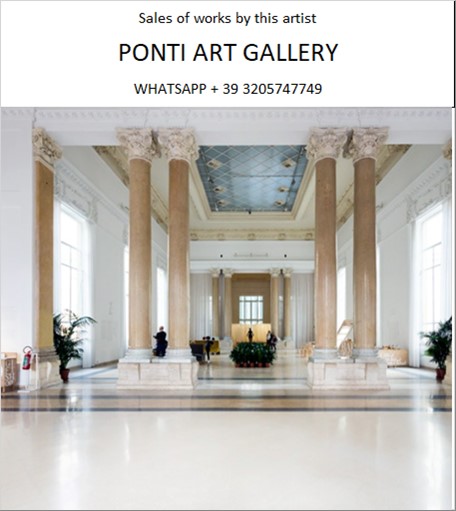Ponti Art Gallery is interested in buying and selling works
of art by this artist.

Philip Guston Biography
Philip Guston, born Philip Goldstein in 1913 in Montreal, Canada, was a prominent and controversial figure in the 20th-century art world. His parents were Russian Jewish immigrants who had fled to Canada to escape persecution. The family later moved to Los Angeles in 1919, where they encountered the harsh realities of racism and economic hardship. Guston's father, unable to find work and overcome by depression, tragically took his own life, an event that deeply affected the young artist.
Guston's interest in art began early, and he found solace in drawing, often retreating to a closet to sketch by the light of a single bulb, an image that would later recur in his mature work. He attended Manual Arts High School in Los Angeles, where he befriended fellow student Jackson Pollock. Both were expelled for publishing a leaflet that criticized the school's policies, but this did not deter Guston's artistic pursuits. He briefly attended the Otis Art Institute in Los Angeles but left after three months, feeling that the instruction did not satisfy his artistic hunger.
In the 1930s, Guston visited Mexico, where he was inspired by the politically charged murals of the Mexican Revolution. This experience ignited his own social consciousness and led him to join the mural division of the Works Progress Administration (WPA) after moving to New York at Pollock's urging. During this period, Guston created several significant murals that reflected the social and political issues of the time.
By the 1940s, as the WPA program ended, Guston transitioned to easel painting, focusing on more personal and allegorical subjects. His early works were influenced by Renaissance masters, Mexican muralists, and modern European artists. Guston's style evolved from Symbolic Realism into abstraction, and by the 1950s, he had become an established member of the New York School of abstract expressionists, alongside Pollock, Willem de Kooning, and Mark Rothko.
Despite his success as an abstract painter, Guston grew increasingly dissatisfied with the movement. In the late 1960s, amidst the turmoil of the Vietnam War and the civil rights movement, he made a radical shift back to figuration. His new works featured cartoonish figures, including hooded Klansmen, which served as allegories for modern evil and personal struggles. This dramatic change was first unveiled at a 1970 exhibition at the Marlborough Gallery in New York, which was met with harsh criticism from both the public and his peers.
Guston's late works, characterized by their bold, provocative imagery and a limited palette of pinks, reds, and blacks, continued to explore themes of racism, violence, and societal ills. He also delved into autobiographical content, reflecting on his childhood, adult life, and the artistic process. Despite the initial backlash, these paintings eventually gained recognition and are now considered some of his most important contributions to art history.
Guston's career was marked by constant evolution and a refusal to conform to any single artistic doctrine. His work spanned social realism, abstract expressionism, and a unique form of cartoon realism, making him a pivotal figure in the transition from modernist to contemporary art. He continued to paint and exhibit until his death in 1980, just weeks after the opening of a major retrospective at the San Francisco Museum of Modern Art.
Today, Philip Guston's legacy is celebrated for its fearless confrontation of challenging subjects and its profound influence on younger generations of artists. His work is held in major museum collections worldwide and continues to provoke discussion and debate, underscoring his relevance in the contemporary art discourse.
Philip Guston Quotes and Sales
of Works
Ponti Art Gallery selects and deals with paintings by the
artist. Upon request, we provide free estimates and
evaluations, communicate prices, quotations, and current
market values.
If you are interested in BUYING or SELLING works by the
artist, contact us immediately.
If you wish to sell or receive an evaluation of the
works:
Send us a frontal photo of the painting, one of the back,
and one of the signature. Also, indicate the dimensions of
the work. Inform us about the purchase origin of the work
and any kind of available documentation (purchase
receipts, certificates of authenticity, publications). One
of our operators will respond to you on the same day. We
guarantee maximum confidentiality and extreme
professionalism.
If you wish to purchase works by the painter: Contact us
and let us know your request. We will inform you about the
available works. We also offer the possibility to
subscribe to our NEWSLETTER, through which you will be
informed at the beginning of each month about the latest
acquisitions of the art gallery.
You can send us pictures of the work:
